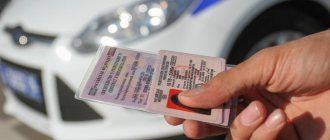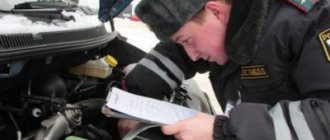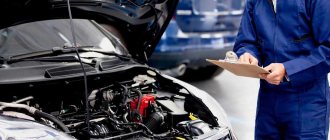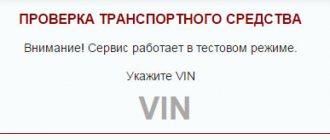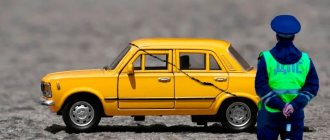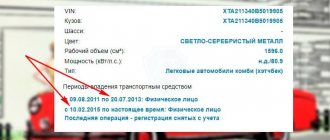AutoUrayt.rf / Questions
Back
Published: March 15, 2019
Reading time: 5 min
0
1152
Stopping a vehicle by a traffic police inspector is already an unpleasant situation that can throw the driver off balance. And conducting an inspection is a good reason for stress! How to behave? What laws to operate with? How is the procedure performed? To what extent do the powers of traffic police officers extend? These and many other issues will be addressed in the article, after reading which any driver will be able to protect his rights while acting within the law.
- The procedure for conducting a vehicle inspection by a traffic police officer
- The main differences between a search and a car inspection
- Grounds for inspection
- The procedure for stopping the vehicle
- Search for witnesses and release of the vehicle interior
- Direct inspection
- Drawing up a protocol
- Witnesses or video recording
- Inspector's responsibility
The procedure for conducting a vehicle inspection by a traffic police officer
All actions of traffic police officers performed in relation to drivers and vehicles are regulated by law. The main regulations that both parties - the driver and the inspector - can refer to in the event of a dispute include:
- Administrative regulations approved by Order of the Ministry of Internal Affairs of the Russian Federation No. 664 of August 23, 2017
- Code of Administrative Offenses of the Russian Federation
The search is also carried out in compliance with the articles of the listed laws . But it is possible that both parties to the procedure may interpret them in their own way, making mistakes and violations.
Inspectors rarely conduct inspections of vehicles, in most cases limiting themselves to checking documents. But drivers must be prepared for a different turn of events, which means they must know well how the search is carried out and how to protect their rights if an official openly exceeds his authority. After all, refusing or obstructing an inspection can entail serious consequences - arrest for up to 15 days (Part 1 of Article 19.9 of the Administrative Code).
Reasons for inspecting a vehicle
Let's consider the updated list of grounds (reasons) for inspecting a vehicle:
149. The grounds for inspection of the vehicle and cargo, that is, visual inspection of the vehicle and transported cargo, are:
- orientation, instructions in accordance with the purposes of special events 1; 1 Clause 23 of Part 1 of Article 11 of the Law of the Russian Federation “On the Police”.
- the need to reconcile the markings of the vehicle with the entries in the registration documents (clause 83 of these Administrative Regulations) 1; 1 Clause 23 of Part 1 of Article 11 of the Law of the Russian Federation “On the Police”.
- presence of signs of non-compliance of the transported cargo with the data specified in the documents for the transported cargo 1; 1 Clause 23 of Part 1 of Article 11 of the Law of the Russian Federation “On the Police”.
- existence of grounds to believe that the vehicle is being operated in the presence of malfunctions or conditions under which its operation is prohibited 1. 1 Clause 1 of Part 1 of Article 28.1 of the Code.
149. The grounds for inspection of the vehicle and cargo, that is, visual inspection of the vehicle and transported cargo, are:
- orientations, other information about their use for illegal purposes 1; 1 Clause 20 of Part 1 of Article 13 of the Federal Law “On Police”.
- the need to reconcile the markings of the vehicle with the entries in the registration documents (clause 83 of these Administrative Regulations) 1; 1 Clause 20 of Part 1 of Article 13 of the Federal Law “On Police”.
- presence of signs of non-compliance of the transported cargo with the data specified in the documents for the transported cargo 1; 1 Clause 20 of Part 1 of Article 13 of the Federal Law “On Police”.
Please note that the last item has been excluded from the list of grounds for inspecting a (visual) car. Now traffic police officers cannot inspect a car even if they have reason to believe that the car is faulty.
Let me remind you that the list of malfunctions and conditions under which the operation of vehicles is prohibited also contains a clause prohibiting the operation of vehicles with excessively tinted windows.
In this case, the capabilities of traffic police officers are somewhat curtailed.
The main differences between a search and a car inspection
Inspection or inspection? For most motorists, the differences in these concepts are insignificant or completely unnoticeable. But from the point of view of the law (Administrative Regulations approved by Order of the Ministry of Internal Affairs of the Russian Federation No. 664 dated August 23, 2017), the difference between them is significant. It's easier to track it in a table.
| Procedure name | Characteristic | |||||
| Formulation | Driver's consent | Exit from the passenger compartment for the driver and passengers | Examination of personal belongings in the car | Availability of grounds | Protocol | |
| Inspection | Visual examination of the vehicle without entering inside | + | — | — | — | — |
| Search | Actual content control | — | + | + | + | + |
In addition to the above wording of the actions of authorized persons when stopping a car, there is another one - “search” . The Law “On the Police” states that as part of these manipulations, the inspector can independently touch and move things inside the vehicle and violate its integrity . But the search is preceded by:
- Initiation of a case
- Issuance of the relevant resolution
If an inspector classifies his actions as an inspection, but independently opens the bags in the car, lifts the seats, opens the hood, and so on, then he violates Art. 27.9 of the Code of Administrative Offenses of the Russian Federation and may be punished with a fine of 20,000 rubles.
Car inspection: how is it carried out, and what can the inspector do?
Who and where can conduct an inspection?
“Officials in the performance of a state function” are authorized to conduct vehicle inspections – that is, any police officers in the performance of their duties. The search can be carried out both at a stationary checkpoint and when the driver is stopped on the road by traffic police.
What are the grounds for conducting an inspection?
Clause 202 of the administrative regulations of the traffic police indicates in which cases the inspector can conduct an inspection of the car. The reasons for conducting an inspection include
- checking data on the presence of weapons, explosives, drugs, precursors, toxic or radioactive substances in the car;
- checking data on the presence of instruments for committing an administrative offense or objects of violation;
- detaining criminals and violators traveling in a car.
Despite the fact that the list of grounds for inspection seems small, many factual situations fall under it - from establishing the identity of passengers to checking the contents of the trunk for stolen property.
Is the inspector required to explain the reason for the inspection?
Before conducting an inspection of a car, the inspector must voice the reason for it, and also indicate it in the inspection protocol drawn up based on the results of the procedure. In particular, according to Appendix No. 12 to the administrative regulations, the inspector is asked to choose whether the reason for the search was “reasonable assumptions” about the presence of weapons, explosives or drugs in the car, or about any connection between the car or its contents and an administrative offense.
What is vehicle inspection and how is it carried out?
The formal definition of vehicle inspection is given by both the administrative regulations of the State Traffic Safety Inspectorate and the Code of Administrative Offenses: according to Article 27.9 of the latter, vehicle inspection is “an examination of a vehicle carried out without violating its structural integrity
" That is, the inspector may ask the driver to open the trunk, doors and hood of the car, if necessary, even inspect the space under the fuel filler flap or ask to remove the cover from the seat, since it is not a structural element.
A mandatory condition for conducting an inspection is the presence of two witnesses or video recording
official of the inspection process - this is stated in paragraph 203 of the administrative regulations.
In addition, based on the results of the inspection, a corresponding protocol is drawn up
. Therefore, if an inspector offers to “just open the trunk” without witnesses, video recording and a protocol, his actions are unlawful, and the driver has the right to refuse this.
Is the driver required to get out of the car during the search?
According to paragraph 93.1 of the administrative regulations, the inspector “has the right to invite the road user to get out of the vehicle to conduct a personal search, inspection or inspection of the vehicle and cargo.” However, paragraph 207 specifies that “the inspection of the vehicle is carried out after the driver and passengers have left the vehicle and their behavior is monitored by the squad officers.” That is, during a search inside the car, there should be no one in the car.
.
Can an inspector conduct an inspection without a driver?
It provides for administrative regulations and the possibility of conducting an inspection without the owner of the car - but, as paragraph 204 says, only “in urgent cases.” However, under normal conditions, the search should be carried out in the presence of the owner of the car.
What is the difference between a search and an inspection?
Sometimes inspectors, asking the driver to open the trunk, motivate this by conducting an “inspection”. However, in fact, paragraph 197 of the regulations specifies that an inspection is a “visual examination of the vehicle and the cargo being transported”: that is, the inspector has the right to conduct an external inspection of the car, looking into the interior through the side windows. In this case, the grounds for inspection are orientation and verification of body and engine numbers
.
Is it possible to refuse to sign the inspection protocol?
As mentioned above, based on the results of the inspection, an appropriate protocol must be drawn up, which, according to paragraph 212 of the administrative regulations, is signed “by the official who compiled it, the person in respect of whom the proceedings for an administrative offense are being conducted, and (or) the person in charge of who owns the vehicle subjected to inspection, as well as witnesses if they participate.” In this case, the owner of the car has the right to refuse to sign the protocol - in this case, a corresponding entry will be made in the protocol. However, the inspector must still give the driver a copy of the inspection report.
Grounds for inspection
This moment in the entire procedure raises the most questions. The main thing that the driver must remember is that the inspector’s words, not supported by documents, will not be grounds for inspection . This behavior is a direct violation of Art. 27.9 of the Code of Administrative Offenses of the Russian Federation and Order 664.
More on the topic: Transporting children in a car. Up to what age is a child seat required in a car?
The traffic police officer does not have the right to conduct an inspection at his own discretion . Legitimate reasons for checking a car will be:
- Availability of orientation for this vehicle
- Detention of persons in a car (Part 2 of Article 14 of Law 3-FZ of 02/07/2011 “On the Police”)
- Checking the information received about the participation of a car in a crime or offenses of various nature (information can be sent from traffic police posts, road users and more)
- Confirmation or refutation of data on the presence in the vehicle of objects with the help of which it is possible to commit an offense
- Checking information on the transportation of weapons, poisons and other dangerous substances
Previously, refusal to inspect a car became a reason for conducting a thorough search without the consent of the car owner. But in 2021, in the new reading of the regulations, such an item in the list of grounds does not exist.
Before starting the inspection, the driver has the right to check all the reasons given by the inspector by calling the duty station. The traffic police officer must provide the required telephone number.
If an authorized person deliberately detains the owner of a vehicle without carrying out the search procedure, despite notification of its beginning, the driver can immediately complain about unlawful actions by calling the duty station or any police department.
The reason for inspection cannot be the announced “Interception” plan. In peacetime, it only serves as a reason to stop the vehicle and check documents. But in wartime or in the event of martial law being introduced in the country, this is quite enough for a thorough inspection of any car.
In what cases does a traffic police inspector have the right to inspect a car?
The car owner should approach the inspection differently, since this procedure includes deeper concepts. This is an in-depth study of the car and the contents that are in the trunk, interior and any part of the vehicle.
Since this vehicle is the private property of the car owner, its inspection is permissible only in special cases permitted by Russian legislation. When and how a car can be inspected by a traffic police inspector is determined by a list of reasons allowing it:
- performance of special operations by traffic police officers;
- reconciliation of vehicle passport numbers and markings for the purpose of primary identification of the vehicle;
- when a traffic police inspector identifies a malfunction in the condition of the vehicle, the further operation of which may create an emergency situation on the road;
- to check the presence of prohibited items in transport;
- assumption of transportation in this vehicle of drugs, psychotropic substances, explosives, and wanted crime subjects;
- reasonable verification of the compliance of documents and transported cargo.
Before a vehicle is inspected by a traffic inspector, the driver must make sure that there are valid traffic police officers in front of him. Service IDs give them the right to conduct searches, but at the same time have justification for this procedure.
Article for driving without a license.
Find out how to appeal a parking fine here.
Where to go if you disagree with traffic police fines, read the link:
The inspector’s mention of a mass inspection of cars is unlawful and does not correspond to reality, since this event is permissible only in conditions of a declared military or emergency situation.
A vehicle inspection should be carried out only in the direct presence of the vehicle owner, and the inspector does not have the right to:
- open car doors and trunk;
- touch things inside the car and trunk;
- The inspector must carry out all inspection procedures by asking the owner of the vehicle to open and show the objects in the car;
- during the inspection process, it is mandatory to draw up a protocol, which must indicate the reasons for the inspection;
- the inspector does not have the right to conduct an inspection procedure without witnesses.
Important! If a traffic police inspector conducts an inspection of a car without drawing up a report, turning the inspection into a search, opening the interior and trunk, turning over the contents, you should not interfere with his actions, trying to record the event on a phone camera or DVR, attracting witnesses. This behavior of civil servants of the traffic police is qualified by the Code of Administrative Offenses, Article 19.1.
Procedure
According to the Administrative Regulations approved by Order of the Ministry of Internal Affairs of the Russian Federation No. 664 dated August 23, 2017 and the Code of Administrative Offenses of the Russian Federation, in the legal field the inspection procedure will look like this:
- Car stop
- Presentation of documentary grounds for stopping and searching
- Search for 2 witnesses
- Emptying the vehicle interior by the driver and passengers
- Thorough inspection of the vehicle by an inspector, including the trunk and cargo
- Drawing up a protocol on the procedure performed
- Signature left by both parties
- Transferring a copy of the protocol to the driver
It seems that everything is extremely simple and there should be no questions, let alone disputes regarding the inspection procedure. But in practice, both car owners and inspectors make mistakes during inspection. Therefore, some items from the above list will be discussed in more detail.
Vehicle stop
The traffic police officer on duty has every right to stop the car near the checkpoint and in any other place - in the city and beyond. At the same time, he can wave not only the wand, but also his hand. In both cases, the driver must stop.
More on the topic: Who should yield when changing lanes and who will be to blame for an accident?
The exception is situations when the inspector calls for stopping in places where this is prohibited by markings or road signs.
When the stop is made, the driver can calmly wait for the traffic police officer, who is obliged to:
- Introduce yourself verbally
- Provide reason for delay
The vehicle owner may request an inspector's certificate, which is provided upon request. Of greatest interest in the document are:
- Number
- FULL NAME. the official who made the stop
The listed data can be copied into a notepad. It is prohibited to photograph them .
Search for witnesses and release of the vehicle interior
The following cannot be witnesses:
- Passengers of a stopped car
- Traffic police officers
The inspector must appoint witnesses from random passers-by or stop another car for this purpose. Uninterested persons must provide the traffic police officer with identification cards, the data from which will be entered into the protocol.
Vehicle inspection is carried out only if the interior is empty . The driver and passengers are required to get out of the car, but be present during the procedure and facilitate its implementation within the legal framework. In this case, it is permissible to video and photograph the process.
Direct inspection
Here inspectors often exceed their powers. Therefore, any driver should know that:
- The official cannot touch personal belongings with his hands, open the trunk, hood and glove compartment - at his request, all such actions are performed by the owner of the vehicle
- Sealed cargo cannot be opened - it is reported by radio to the duty station and only after receiving the appropriate orders (this is done in the most extreme case, when there is a direct threat to life) the integrity of the seal is broken
- The squad officers do not prevent the driver from being near his car, but in case of suspicion that he has committed a criminal offense, they have the right to partially restrict his freedom (with handcuffs)
- If an administrative offense or other crime (committed or planned) is detected during the inspection, the inspector draws up a corresponding document.
In the first case, it will be a case of offense opened by the traffic police officer himself. In the second, a report is transmitted to the investigative team sent to the inspection site by calling the duty station.
Drawing up a protocol
Based on the results of the inspection, the authorized person draws up a protocol. It states:
- Inspector details: Full name, title, position
- Place and date
- Details of the person driving the vehicle: full name, date of birth, number and date of issue of driver’s license, place of registration, residential address, telephone
- Vehicle identification features
- Details of witnesses: full name, date of birth, place of registration, residential address, telephone
The protocol sets out in detail the procedure for conducting the search and the material evidence discovered during it (they must be photographed and printed out attached to the document) of the guilt of the vehicle owner in the criminal actions charged to him.
More on the topic: Is it legal to install LED lamps in headlights?
The protocol must be handed over to the interested party for review. If he disagrees with any of the information presented, he has the right to refuse to sign the document.
Refusal to leave a signature must, according to the regulations, be reflected in the protocol. In any case, the driver receives a copy of the paper.
The procedure may be accompanied by the confiscation of any items from the owner. This fact and a list of things must be included in the protocol. If this is not done, the driver must point out the omission to the inspectors. Witnesses must also be present during the communication between the inspector and the person driving the vehicle.
Witnesses or video recording
It happens that the inspector refuses to look for witnesses, citing official video recording. Such actions cannot be classified as lawful. The law does not oblige traffic police officers to film the search. It is permissible to carry it out on their own initiative by both parties. But the presence of witnesses is a prerequisite for the legality of the search . Therefore, the driver must insist on their presence.
In a situation where the search is carried out in a deserted place and searching for witnesses is not possible, the driver must agree to official video recording.
Procedure
Typically, a vehicle search is preceded by a police officer’s offer to present documents for the car, as well as things or objects that are the instrument or subject of the offense, if any.
Next, if there are grounds, the traffic police officer begins to inspect the car in accordance with the following rules:
Owner presence
An inspection is possible only in the presence of the car owner or driver - that is, the person in whose possession the vehicle is at the time of the procedure. At the same time, this is a general rule, from which the law provides for an exception: you can inspect a car without the owner if the situation is urgent.
Such an exception in practice gives rise to cases of abuse of power by police officers. This happens partly due to the lack of a clear interpretation in the law of what is considered an urgent case. Apparently, in each specific situation, urgency is assessed individually - for example, when there is a threat to life or health. Don’t forget about the rules of Part 3 of Art. 26.2 of the Code of Administrative Offenses of the Russian Federation, which allows you to exclude from reliable evidence information obtained in violation of the requirement for the presence of the owner.
Can passengers and the driver be inside the car while the inspector opens the luggage compartment? The code says nothing about this, but the new Administrative Regulation No. 664, which came into force in October 2021, orders passengers and the driver to leave the car before the search begins. These persons must be nearby, within the field of view of employees.
Availability of witnesses or video recordings
Inspecting a car is permitted only in the presence of at least two witnesses or under video surveillance. It is possible to use both methods of recording at the same time, but if there are no witnesses and there is no video recording, there will subsequently be compelling reasons to recognize the actions of the police as illegal.
Who can be a witness? Random drivers, passers-by - those who are not familiar with the driver or the official conducting the procedure, that is, independent persons. They must be present from the beginning to the end of the inspection, put their signatures in the protocol, give their real personal data, telephone number, and residential address.
A driver whose vehicle has attracted the attention of the police has the right to express written disagreement with the choice of a candidate for witness.
Example No. 3 . Molchanov K.E. was stopped on the road by traffic police officers who considered it necessary to inspect his vehicle. When drawing up the protocol, they began to write down two persons as witnesses - P.R. Lesakov. and Zhidkova G.N. The driver noticed that these individuals had an unsteady gait and a strong odor of alcohol coming from their breath. He verbally reported these circumstances to an official, who ignored the information received. Then the driver entered his comments into the protocol, which subsequently became the reason for the protocol being declared not to comply with the law.
In judicial practice, there are cases when police officers become witnesses. For example, in one of the cases, an employee of the internal affairs department was brought in as a witness during the search. This was an investigator who had nothing to do with the State Traffic Inspectorate. And yet, the court declared the protocol drawn up illegal, since the police officer cannot be considered an independent person recording the procedural action. We are talking about indirect official interest - attention is drawn to this in the explanations of the Supreme Court of the Russian Federation, which states that it is inadmissible for a law enforcement officer to be understood, because this casts doubt on the document drawn up and the objectivity of the procedure as a whole.
In accordance with the Administrative Regulations of the Ministry of Internal Affairs, video recording by employees is carried out using video recorders, which must be equipped with patrol cars. In addition, each inspector must be issued wearable recorders.
The issue of non-standard situations, which exclude the possibility of both attracting witnesses and conducting filming, was publicly discussed with the head of the traffic police department of the main department of the traffic police of the Ministry of Internal Affairs of Russia. An opinion was expressed about the admissibility of filming even on the inspector’s personal phone if, for example, the need for an inspection arose in a deserted place where it is difficult to find witnesses, and the office video recorder was out of order. How justified such actions of an official will be will be shown by judicial practice, which is still just being created.
Actions in case of detection of an offense
If during the inspection a crime was revealed, officials report this to the duty station, issues of transporting persons and vehicles to the territory of the internal affairs department are resolved, and a report is drawn up.
If an administrative violation is detected by an employee of the State Traffic Inspectorate, this is reported according to the general rules of the Code of Administrative Offenses of the Russian Federation.
Is it possible to refuse a search and the requirement to get out of the car? It is possible, but if such a requirement is justified, you face liability under Art. 19.3 of the Code of Administrative Offenses of the Russian Federation - disobedience to the legal request of a police officer, for which a fine of up to 1000 rubles or even administrative arrest for 15 days is provided. But if the demand is unfounded, then the refusal to fulfill it is fully consistent with the law, but the driver will have to prove that he is right.
The main document confirming the inspection procedure is the protocol.
Violations that traffic police officers may commit during an inspection
Some inspectors intentionally or unintentionally commit a number of violations during the procedure. Often they are left without recording by the driver, since he himself does not fully understand how exactly the inspection should take place.
The most common errors are:
- Lack of witnesses
- Removal of the vehicle owner from participation in the process
- Independently shifting things, which is already classified as a search
- Refusal to review the protocol
- Requirement to sign the protocol without prior review
- An order to put things out of the trunk
The second party to the inspection has the right to point out violations to the inspector in a polite manner and record it on video.
Inspector's responsibility
If a traffic police officer does not carry out the proper actions, but makes mistake after mistake, then there is no point in arguing with him. All violations can be recorded and included in a complaint within 10 days.
When considering it, officials will be guided by Article 19.1 of the Code of Administrative Offenses of the Russian Federation. If the complaint is confirmed, the inspector will be fined 20,000 rubles.
○ Is there a difference between an inspection and a search?
Many drivers do not distinguish between the concepts of inspection and search, although there is a significant difference between them.
A vehicle inspection is a visual review for the purpose of checking data. For example, you may be asked to open the hood and check the VIN number with that indicated in the registration certificate. He can also look into the cabin through the glass without opening the door or window.
Inspection is a deeper concept that means actual control of the immediate contents of the car. It does not require the driver's consent.
Thus, the main differences between these two actions are as follows:
- The inspection is carried out in a free form, and the search is carried out exclusively in the presence of witnesses (at least 2).
- No reasons are needed for an inspection; the inspector can conduct it simply because it “seemed”, but an inspection already requires good reasons.
- The inspection is carried out with the consent of the driver, but the search is carried out without.
Recommendations for the driver
In any situation, the road user is recommended to:
- Follow orders of traffic police officers
- Keep calm
- To be polite
- Take an active part in all manipulations performed with the car
- Capture what's happening on video
- Take contact details of witnesses and witnesses
Unpleasant situations often arise on the road. But the driver who knows his rights and does not break the law will be able to solve any problem within the legal framework.
○ Conditions under which inspection may be carried out.
The Code of Administrative Offenses of the Russian Federation also regulates the conditions under which an inspection must be carried out. Knowledge of them is mandatory, because it often happens that inspectors demand an inspection without reason. In such a case, you will be able to challenge his actions and the protocol drawn up and even bring him to justice in the form of a fine.
✔ Drawing up a protocol.
After the inspection, a protocol must be drawn up based on its results. The document states:
- Grounds for inspection.
- Data of all participants (driver and witnesses).
- Information about the vehicle.
- The fact of using photo/video shooting.
- Information about detected prohibited items (if any) or the fact of their absence.
The protocol is signed by the inspector who conducted the inspection, the person driving the vehicle and witnesses, if they are involved.
✔ Availability of witnesses.
In accordance with paragraph 2 of Art. 27.9 of the Code of Administrative Offenses of the Russian Federation, the search must be carried out in the presence of two witnesses. These must be disinterested persons who must ensure the legality of the actions of the traffic police officer.
Usually, drivers who are stopped specifically for this purpose are brought in as witnesses. Another inspector or a passenger in your car cannot act as witnesses.
The law allows for an inspection accompanied by video recording if it is not possible to attract witnesses.
✔ Presence of the vehicle owner.
According to clause 3 of Article 27.9 of the Code of Administrative Offenses of the Russian Federation, inspection of a car is carried out strictly in the presence of the person in whose possession it is located or the driver who has a power of attorney to drive the vehicle. This rule can only be violated in emergency cases.
✔ Other conditions.
When conducting an inspection, the inspector does not have the right to touch anything in the car with his hands. You must move the package yourself, which blocks the view, etc. If this rule is violated, we are talking about a search, for which special permission is required.
You are not required to leave the car during the search; such demands are unlawful.
